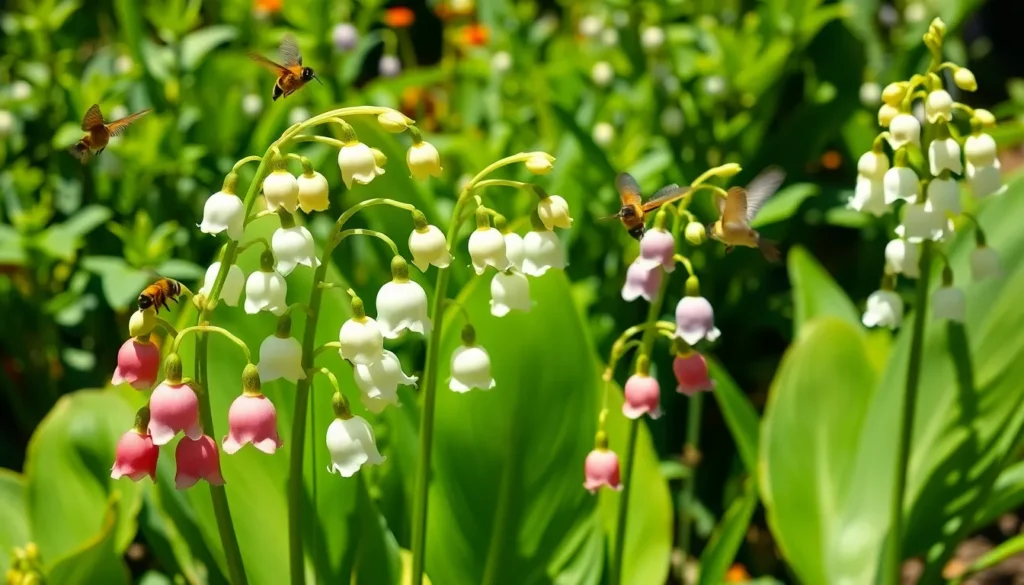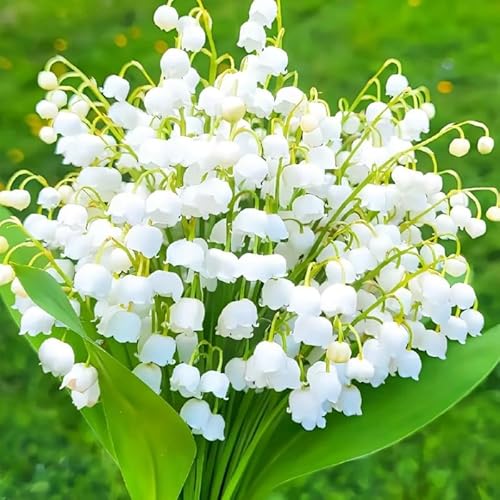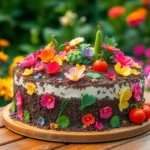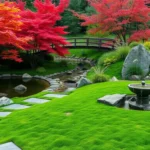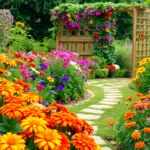Bell shaped flowers captivate gardeners worldwide with their distinctive drooping blooms and elegant charm. We’ve discovered that these enchanting blossoms aren’t just beautiful – they’re incredibly diverse and surprisingly easy to grow in most garden settings.
From the cheerful Canterbury bells swaying in cottage gardens to the delicate lily of the valley carpeting woodland floors, bell shaped flowers offer endless possibilities for creating stunning landscapes. We’ll explore how these unique blooms can transform your outdoor space while attracting beneficial pollinators like bees and hummingbirds.
Whether you’re a seasoned gardener or just starting your green thumb journey, understanding these remarkable flowers opens doors to year-round color and texture. We’re excited to share our expertise on selecting, planting, and caring for the most spectacular bell shaped varieties that’ll make your neighbors stop and admire your garden’s newfound elegance.
Understanding Bell Shaped Flowers and Their Unique Characteristics
Bell shaped flowers captivate gardeners with their distinctive drooping or pendant appearance. We’ll explore the fascinating characteristics that make these blooms so recognizable and beloved in garden design.
What Defines a Bell Shaped Flower
Form and structure create the defining characteristics of bell shaped flowers. These blooms feature a wide opening at the base that gradually narrows toward the top, creating the classic bell silhouette. Petals in these flowers typically fuse together to form a single tubular or campanulate structure rather than separate individual petals.
Orientation plays a crucial role in identifying bell shaped flowers. Most of these blooms hang downward or face toward the ground, though some varieties like bellflowers can face upward or outward. The pendant positioning protects the flower’s reproductive parts from rain and harsh weather conditions.
Size variations among bell shaped flowers range from tiny lily of the valley bells measuring just 5-10mm to large foxglove blooms reaching 5cm in length. Canterbury bells showcase medium sized flowers at 2-3cm, while bluebells typically measure 15-20mm in length.
Common Features of Bell Shaped Blooms
Petal fusion creates the most recognizable feature of bell shaped flowers. Unlike flowers with separate petals, these blooms have petals that grow together from the base to form a continuous tube or cup. This fusion creates the smooth, unbroken outline that gives bell flowers their characteristic shape.
Nectar guides appear as distinctive markings inside many bell shaped flowers. These patterns include spots, stripes, or color gradients that direct pollinators toward the nectar source. Foxgloves display prominent spotted throats, while Canterbury bells often feature subtle color variations.
Stamens and pistils remain hidden within the bell structure in most varieties. This protected positioning keeps the reproductive organs safe from weather damage while still allowing access for appropriate pollinators. The enclosed design also helps concentrate fragrance within the flower chamber.
Color ranges span nearly every hue imaginable in bell shaped flowers. Purple dominates many species like campanulas and foxgloves, while white varieties include lily of the valley and white Canterbury bells. Pink, blue, yellow, and red options provide additional color choices for garden design.
Why Plants Develop Bell Shaped Flowers
Pollinator attraction drives the evolution of bell shaped flowers in many plant species. The pendant shape and enclosed structure appeal specifically to bees, which can easily crawl inside to access nectar. Bumblebees particularly favor these flowers because their size allows them to fit comfortably within the bell chamber.
Weather protection benefits both the flower and visiting pollinators through the bell design. Rain runs off the curved surface without collecting inside the bloom, keeping nectar concentrated and pollen dry. This design extends the flower’s lifespan and maintains its attractiveness to pollinators during wet conditions.
Specialized pollination occurs when bell shaped flowers develop relationships with exact pollinator types. Hummingbirds prefer tubular bell flowers like fuchsias because the shape matches their long beaks and feeding behavior. This specialization increases successful reproduction rates for the plant.
Resource efficiency makes bell shaped flowers advantageous for plants in competitive environments. The fused petal structure requires less energy to produce than multiple separate petals while still creating an attractive display. This efficiency allows plants to produce more blooms with the same energy investment.
Canterbury Bells: The Classic Garden Favorite
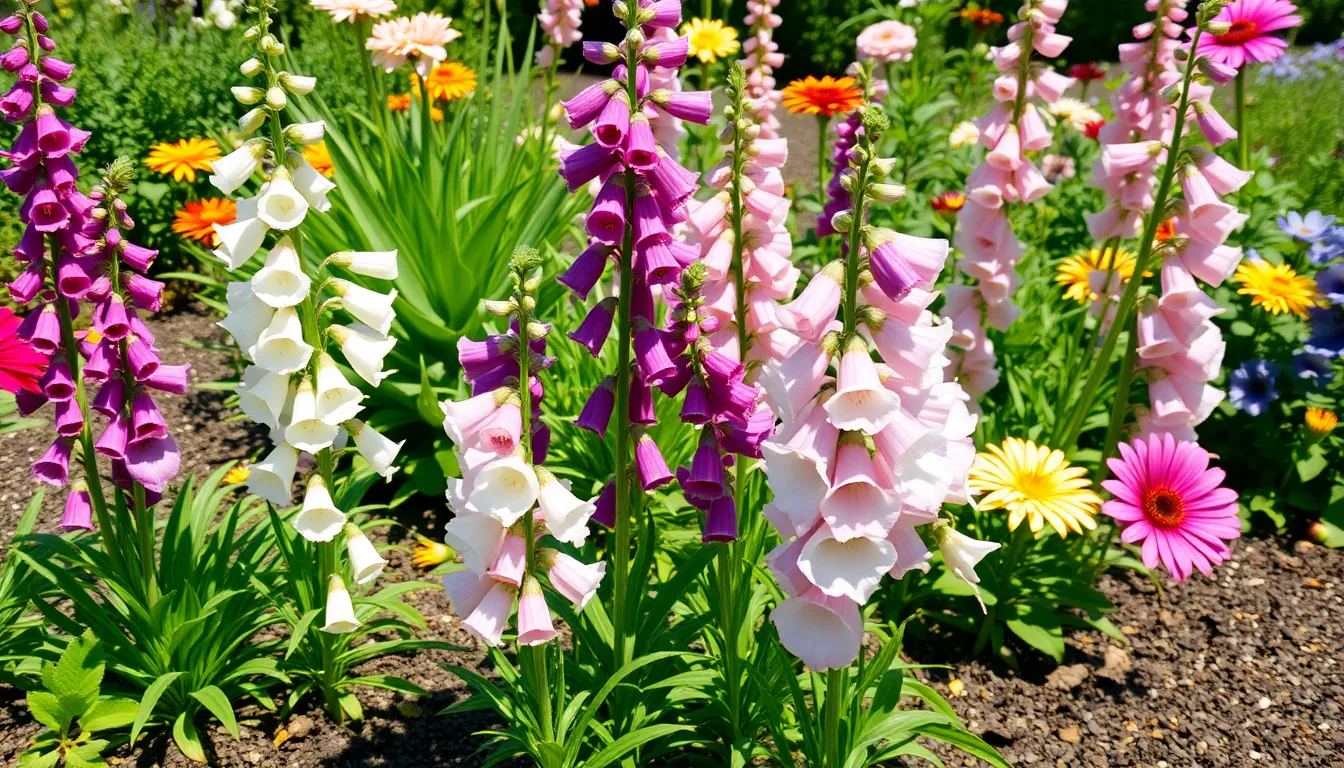
Canterbury bells stand out as one of the most beloved bell shaped flowers in traditional gardens. We’ve found these biennial beauties offer gardeners a perfect combination of elegance and reliability.
Growing Requirements and Care Tips
Light conditions play a crucial role in Canterbury bell success, requiring full sun for four to six hours daily while tolerating partial sun environments. Soil preparation becomes essential with well drained, moist conditions and neutral to alkaline pH levels creating optimal growing environments.
Climate considerations favor cooler regions with low humidity, thriving best in hardiness zones 5 to 8 where temperature fluctuations remain moderate. Fertilization schedules using nutrient rich fertilizer promote healthy blooms throughout their biennial cycle.
Watering practices should maintain consistent moisture without creating waterlogged conditions that damage root systems. Spacing requirements allow adequate air circulation between plants, preventing fungal issues common in humid conditions.
Popular Varieties and Color Options
Traditional varieties showcase an impressive color spectrum ranging from pure white to deep violet, offering gardeners multiple design possibilities. Hybrid selections like ‘Champion White’ provide unique advantages, capable of flowering in the first year when seeded early in the growing season.
Color combinations within single plantings create stunning visual displays, with purple, pink, and white blooms complementing each other naturally. Size variations between cultivars allow for both border plantings and dramatic backdrop arrangements in larger garden spaces.
Bloom characteristics feature the classic bell shaped flowers that give these plants their distinctive appeal and garden recognition.
Best Companion Plants
Foxgloves create exceptional partnerships with Canterbury bells, providing similar architectural structure while extending the vertical interest in garden beds. Dahlias add contrasting texture and vibrant color pops that enhance the overall garden composition.
Bearded irises complement Canterbury bells through their unique shapes and diverse color options, creating layered visual interest. Delphinium varieties share similar growing requirements while adding height variation to mixed perennial borders.
Rose bushes provide excellent backdrop plantings, with their thorny stems offering natural support for Canterbury bell stems during windy conditions.
Foxglove: The Dramatic Vertical Beauty
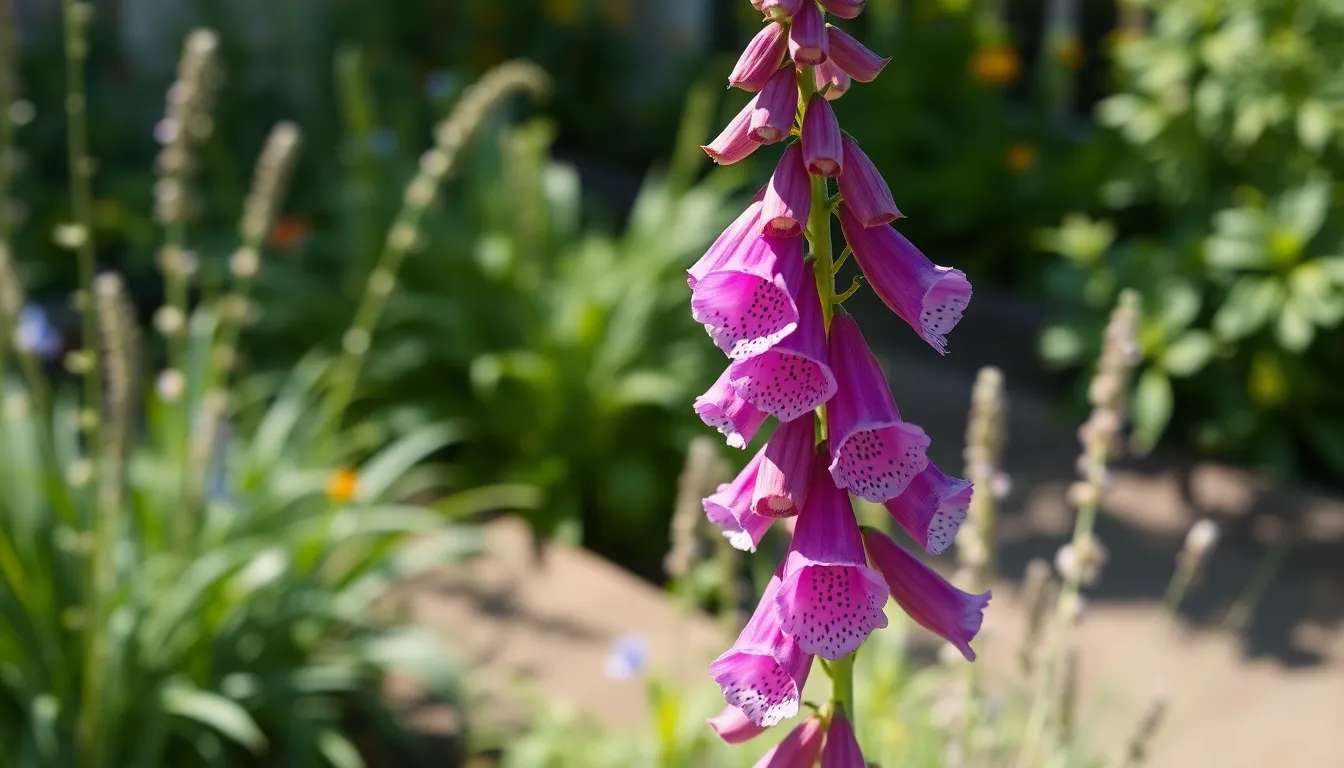
Digitalis purpurea stands tall as one of our most recognizable bell shaped flowers, creating stunning vertical displays that can reach impressive heights of 1 to 2 feet in length. These tubular blooms cluster along towering spikes and showcase predominantly purple hues with distinctive darker spots on their lower lips.
Safety Considerations and Toxicity Warnings
We must emphasize that foxglove contains dangerous cardioactive glycosides throughout the entire plant. Children and pets should never have access to these striking flowers due to their highly toxic nature. Handle foxglove with extreme caution during planting and maintenance to prevent accidental ingestion. Store seeds and plant materials in secure locations away from curious hands and paws. Contact poison control immediately if anyone consumes any part of this bell shaped flower.
Ideal Growing Conditions
Foxglove thrives in well drained soil that receives partial shade to full sun exposure throughout the day. Cooler climates provide the perfect environment for these dramatic bell shaped flowers to flourish. Various soil types accommodate this adaptable biennial, which completes its fascinating two year life cycle by forming rosettes in year one and producing spectacular blooms in year two. Plant foxglove in locations with adequate air circulation to prevent moisture related issues. Water consistently but avoid creating soggy conditions that can damage the root system.
Wildlife Benefits and Pollinator Attraction
Long tongued bees, particularly the common carder bee, find foxglove’s bell shaped flowers irresistible for nectar collection. Our pollinator gardens benefit tremendously from these towering spikes that support biodiversity and network health. Foxglove creates essential habitat connections for beneficial insects while adding dramatic vertical elements to garden designs. These bell shaped flowers extend the blooming season and provide crucial resources when other nectar sources become scarce. Gardens featuring foxglove often see increased activity from various pollinator species throughout the growing season.
Lily of the Valley: Delicate Fragrant Bells
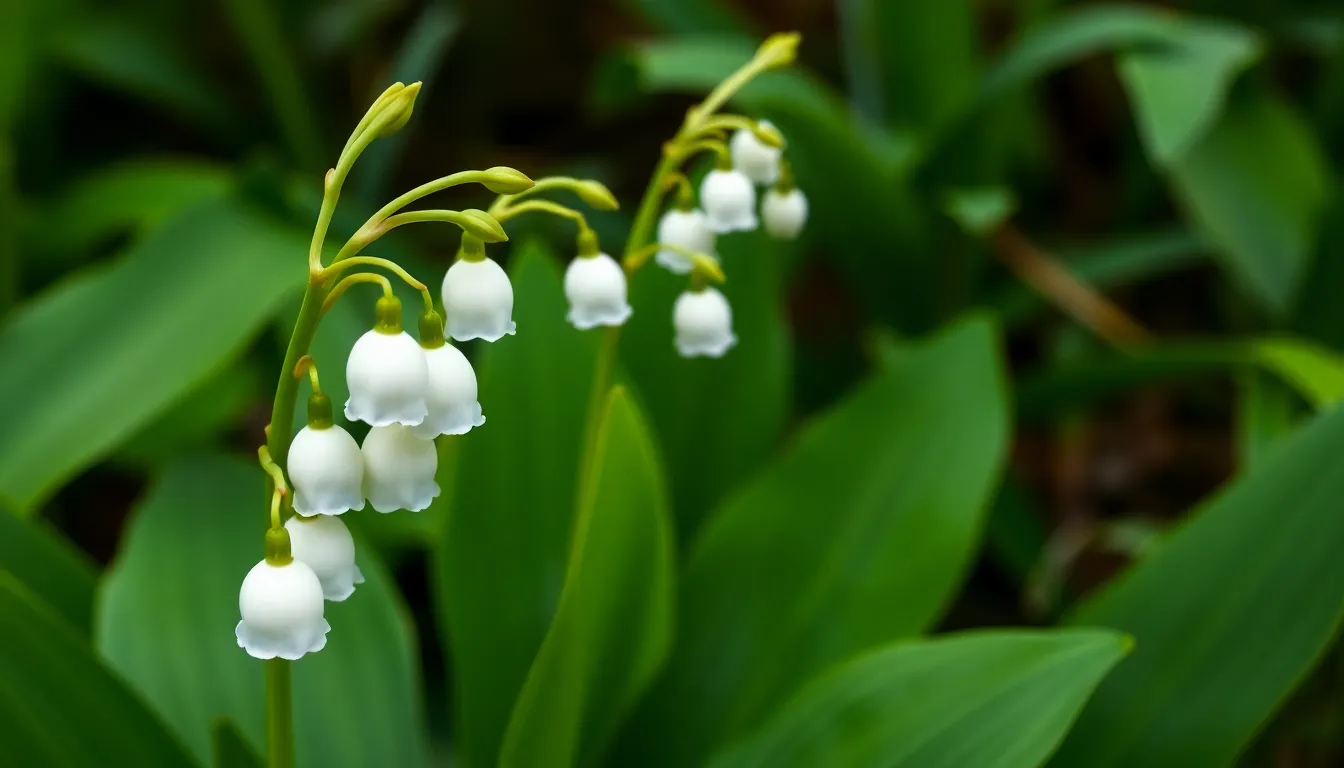
Lily of the Valley produces small white bell-shaped flowers that are highly fragrant and delicate in appearance. We consider these charming blooms essential for creating elegant garden displays and sophisticated floral arrangements.
Shade Garden Applications
Woodland gardens benefit tremendously from Lily of the Valley’s ability to thrive in shaded areas with well-drained soil. We recommend planting these fragrant bells under trees or along shaded pathways where their elegant white blooms can add brightness to darker garden spaces.
Ground cover applications make Lily of the Valley particularly valuable for filling large shaded areas. Spreading through underground rhizomes allows these plants to create dense carpets of green foliage topped with delicate bell flowers.
Rock gardens can incorporate other bell-shaped companions like Campanula species alongside Lily of the Valley in partially shaded sections. We suggest combining these plants to create layered displays that showcase different bell flower varieties throughout the growing season.
Propagation and Maintenance
Division methods work best for propagating Lily of the Valley since these plants spread naturally through underground rhizomes. We recommend dividing established clumps in early spring or fall to create new plantings in other garden areas.
Watering requirements remain moderate for these shade-loving plants, though consistent moisture helps maintain their health and flowering performance. Regular watering during dry periods ensures the rhizomes stay healthy and continue producing new growth.
Pruning needs stay minimal with Lily of the Valley, requiring only removal of spent flowers and yellowing foliage. We suggest cleaning up the planting area in late fall to prevent disease issues and maintain garden appearance.
Traditional Uses and Symbolism
Purity symbolism makes Lily of the Valley a traditional choice for weddings and special ceremonies throughout history. We often see these fragrant bells used in bridal bouquets and arrangements to represent innocence and good luck.
Medicinal applications have utilized Lily of the Valley’s cardiac glycosides in traditional medicine, though we strongly advise against home use due to toxicity concerns. Professional medical supervision remains essential when considering any medicinal applications of these plants.
Cultural significance extends beyond symbolism, with bell-shaped flowers like bluebells representing everlasting love in various traditions. Modesty and humility are common themes associated with bell flower varieties, making them meaningful additions to memorial gardens and contemplative spaces.
Bellflowers (Campanula): Versatile Perennial Options
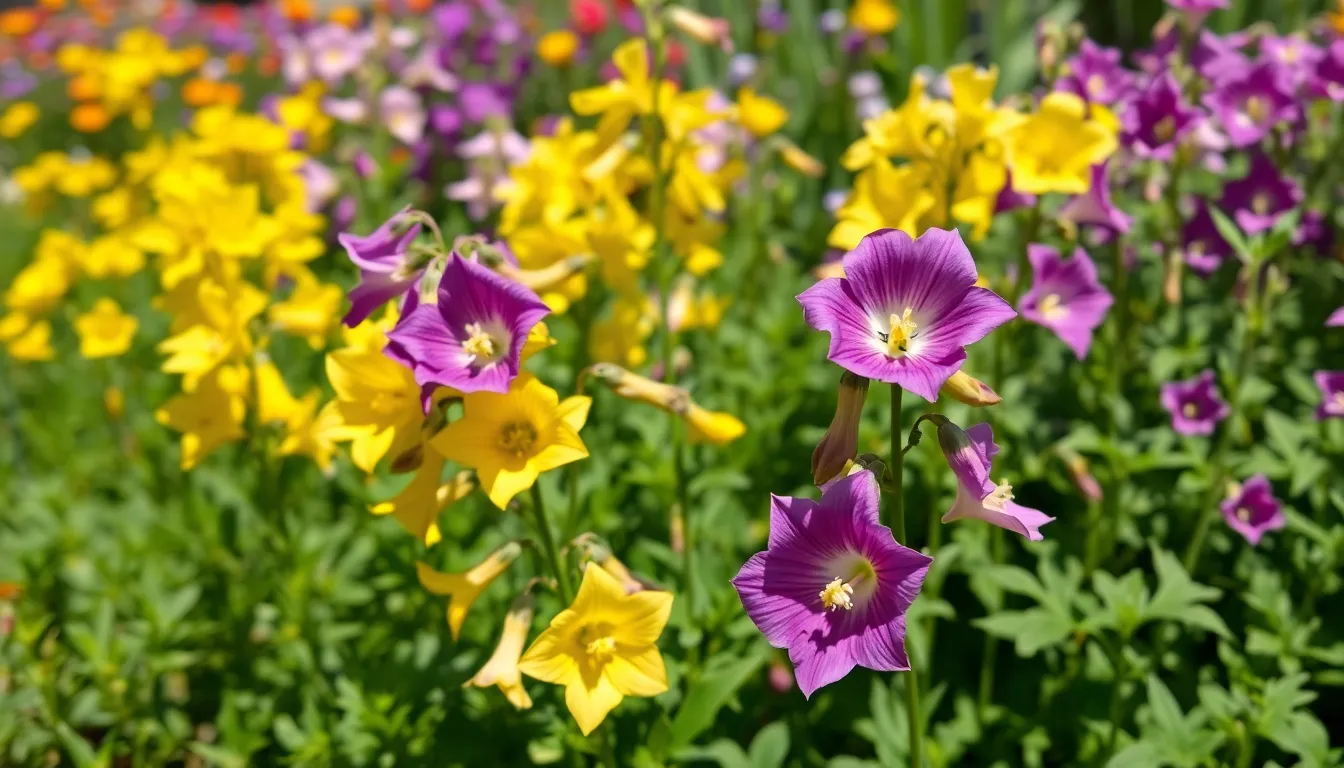
Bellflowers offer remarkable diversity in our gardens with their distinctive bell-shaped blooms and adaptable growing habits. We’ll explore how these perennial favorites can transform your outdoor spaces with their charming flowers and reliable performance.
Different Species and Growth Habits
Clustered Bellflower (Campanula glomerata) creates stunning displays with tightly packed, deep-violet bells that make bold statements in sunny locations. This sun-loving variety thrives in well-drained soil and produces dense clusters of flowers that attract beneficial pollinators.
Yellow Bellflower (Campanula rotundifolia ‘Yellow’) brightens gardens with its cheerful yellow bells that bloom from late spring through early summer. We find this variety particularly effective in rock gardens and border plantings where its compact growth habit shines.
Growth patterns among bellflower species vary from small, compact forms to medium-sized specimens reaching up to 1 meter in height. Most varieties adapt well to different light conditions, flourishing in environments ranging from full sun to partial shade.
Flower characteristics remain consistent across species, featuring the signature bell shape in colors spanning yellow, purple, pink, and white. These blooms typically measure 1-2 inches across and appear in clusters or along tall stems depending on the variety.
Rock Garden and Border Applications
Compact growth habits make bellflowers ideal candidates for rock garden installations where space is limited and drainage is excellent. Their moderate size allows us to create layered displays without overwhelming smaller companion plants.
Pollinator attraction becomes a important benefit in border applications, as bees and butterflies regularly visit bellflower blooms throughout the growing season. We’ve observed increased garden biodiversity in areas where bellflowers are established.
Color versatility enables seamless integration into various garden styles, from cottage gardens to modern landscapes. Purple varieties complement silver foliage plants, while yellow forms brighten shaded corners and woodland edges.
Spreading characteristics help bellflowers fill gaps in borders naturally without becoming invasive, creating cohesive garden displays over time.
Seasonal Care and Pruning
Soil requirements center on well-drained conditions, as bellflowers struggle in waterlogged areas that can lead to root rot. We recommend amending heavy clay soils with compost or sand to improve drainage.
Watering practices should maintain consistent moisture without creating soggy conditions, particularly during establishment periods and dry summer months.
Hardiness zones 4-8 accommodate most bellflower varieties, making them suitable for diverse climate conditions across temperate regions.
Pruning timing proves critical for maintaining plant health and encouraging continued blooms. We deadhead spent flowers immediately after blooming to prevent unwanted seed production and redirect energy into new growth.
Seasonal maintenance includes cutting back stems in late fall after the first frost, leaving about 2 inches of growth above ground level. This practice helps prevent disease issues and prepares plants for healthy spring emergence.
Division requirements occur every 3-4 years to maintain vigor and prevent overcrowding, with early spring or fall providing optimal timing for this maintenance task.
Bleeding Heart: Heart-Shaped Bell Blooms
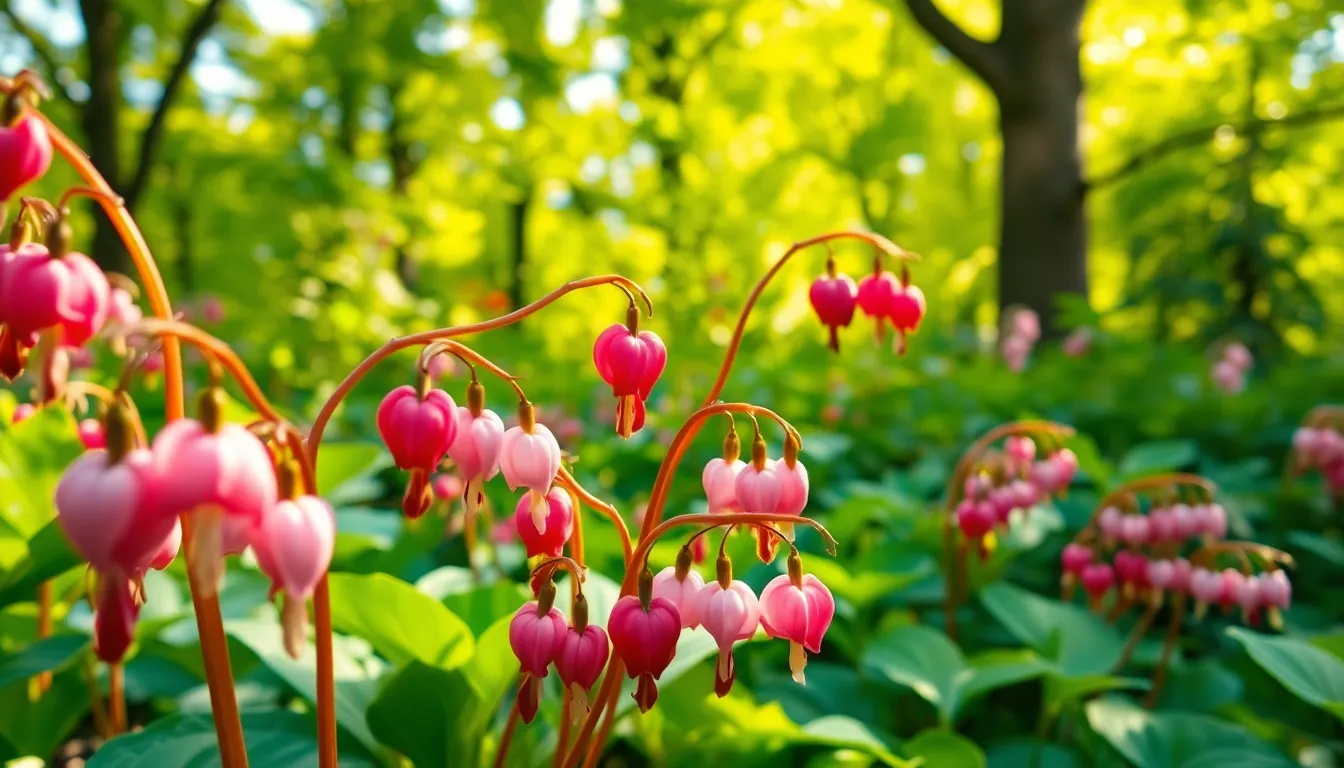
We’ll explore bleeding heart plants, which produce distinctive heart-shaped bell blooms that add romantic charm to spring gardens. These drooping pink and red flowers hang gracefully from arching stems, creating an enchanting display in woodland settings.
Spring Garden Impact
Bleeding hearts bloom in early spring, providing vibrant color when most other perennials haven’t yet emerged. Their heart-shaped bell flowers appear before the garden reaches full activity, making them valuable early season performers that extend our growing season enjoyment.
Soil preferences for optimal spring blooming include humus-rich, moist, well-draining conditions with slightly acidic to neutral pH levels. Growth habit remains compact yet spreading, allowing bleeding hearts to fill gaps in spring borders effectively. Light requirements vary from light shade to full sun in cooler climates, giving us flexibility in garden placement.
Woodland Garden Integration
Shade tolerance makes bleeding hearts ideal candidates for woodland gardens, where they thrive under tree canopies and in shaded borders. Natural woodland conditions provide the filtered light these bell-shaped flowers prefer, creating authentic habitat settings.
Complementary plantings with ferns and hostas produce lush, layered displays that enhance our woodland garden’s texture and visual interest. Strategic placement near shade-loving companions allows bleeding hearts to contribute to cohesive planting schemes while maintaining their distinctive heart-shaped bell flower appeal.
Division and Long-Term Care
Division timing occurs every 3-4 years to maintain plant vigor and promote new growth in established bleeding heart colonies. This maintenance practice prevents overcrowding while expanding our bell-shaped flower displays throughout the garden.
Pruning practices involve cutting foliage to ground level once it turns yellow and wilts, typically during summer months. Summer dormancy follows the spring blooming period, requiring this seasonal cleanup for plant health. Fertilization schedule includes applying time-release fertilizers and compost in spring to support robust growth and abundant heart-shaped bell blooms.
Coral Bells: Colorful Foliage and Delicate Flowers
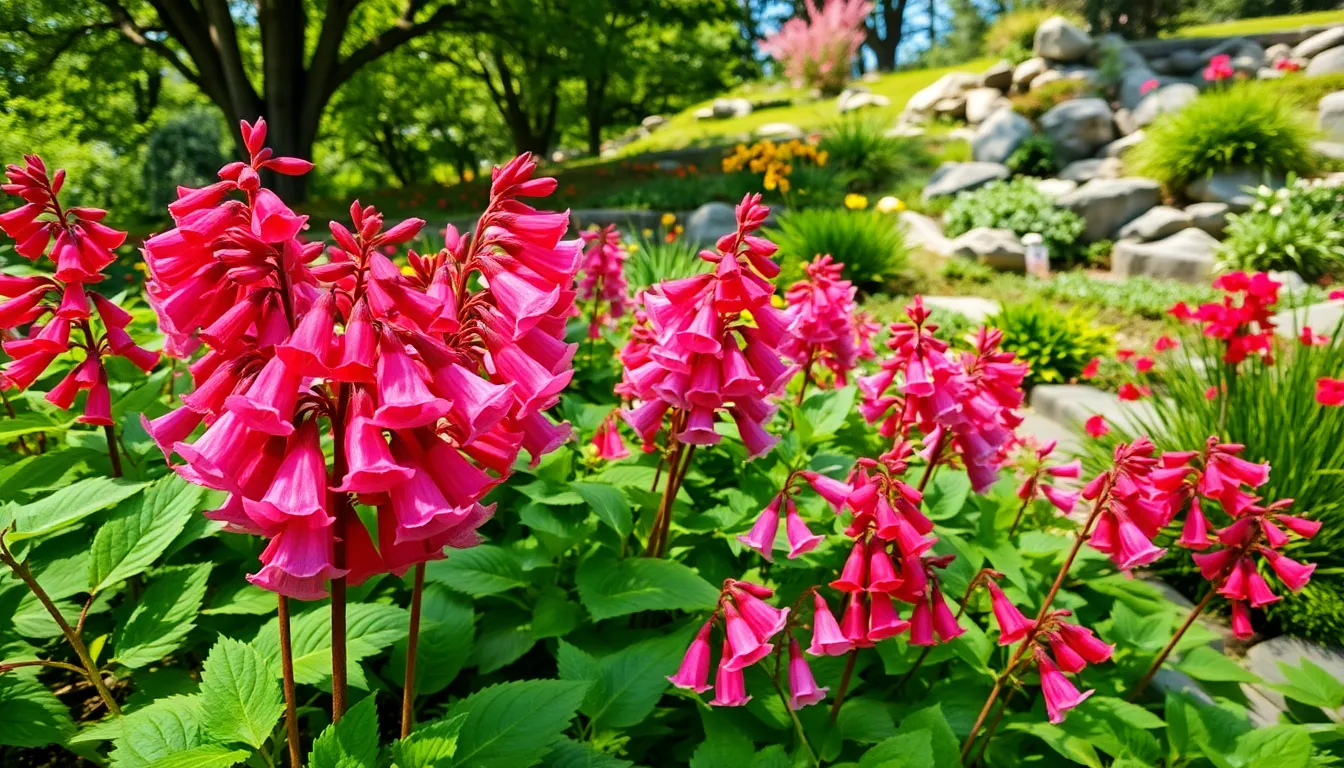
Coral bells (Heuchera) bring exceptional versatility to bell-shaped flower gardens with their stunning foliage displays and charming late spring blooms. These hardy perennials thrive in zones 3 to 9, making them accessible choices for gardeners across diverse climates.
Foliage Varieties and Seasonal Interest
Color combinations in coral bells create year-round garden interest with their evergreen leaves showcasing shades of red, pink, gold, silver, and purple. Texture variations range from smooth, glossy surfaces to ruffled, deeply lobed edges that catch light beautifully throughout seasons.
Seasonal blooms emerge in late spring and early summer, producing delicate bell-shaped flowers on slender stems that rise 12 to 18 inches above the foliage mounds. Wildlife attraction occurs naturally as these sweetly fragrant blooms draw bees and hummingbirds to gardens, with H. sanguinea varieties offering particularly showy deep pink to red flowers.
Winter performance sets coral bells apart from other perennials since their colorful leaves persist through cold months, providing structural interest when most plants have died back. Growing habits maintain compact mounds approximately one foot tall with individual leaves spanning 3 to 5 inches across.
Container Growing Options
Container success makes coral bells ideal for small gardens, patios, and balconies where space limitations restrict ground planting options. Drainage requirements become easily manageable in containers, allowing us to provide the well-draining soil conditions these plants prefer.
Partial shade tolerance works perfectly for container placement on covered porches, under pergolas, or in areas receiving morning sun and afternoon shade. Portability advantages let us move containers to optimize growing conditions throughout seasons or create focal points for special occasions.
Companion planting in larger containers pairs coral bells with other shade-loving plants like small ferns, begonias, or trailing ivy for layered textures and extended seasonal interest.
Industry Design Applications
Edging excellence positions coral bells as perfect border plants that define garden beds with consistent color and texture throughout growing seasons. Companion plant compatibility allows seamless integration with hostas, astilbe, and other shade perennials for cohesive woodland garden designs.
Natural habitat replication becomes achievable when we use coral bells to recreate dry upland woods or rocky hillside environments in our industry designs. Rock garden integration works particularly well since many species naturally occur in rocky, well-draining environments.
Mass plantings create dramatic color sweeps when we group multiple coral bells varieties together, combining different foliage colors for striking visual impact. Transitional zones between sun and shade areas benefit from coral bells’ adaptability, helping bridge different garden microclimates smoothly.
Bluebell: Naturalized Woodland Carpets
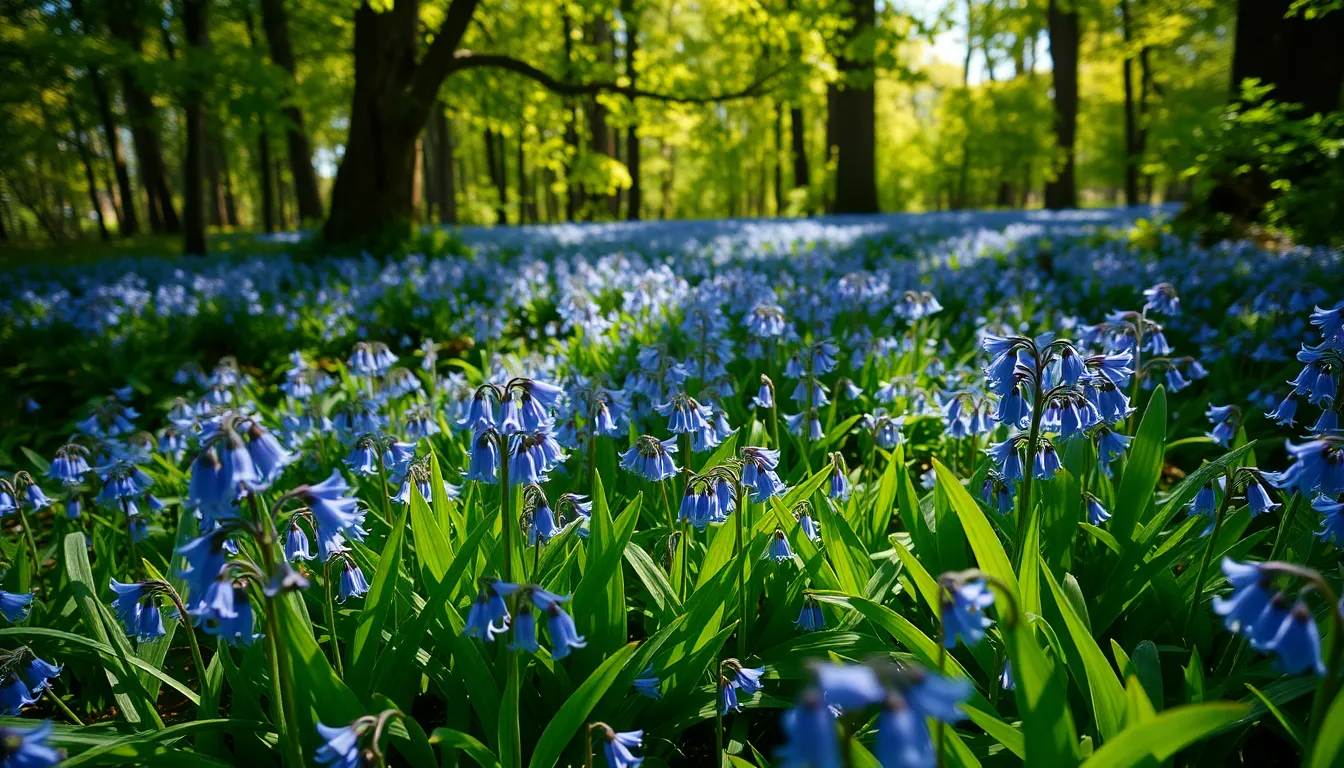
Bluebells create some of nature’s most breathtaking displays when they naturally carpet woodland floors in vivid blue drifts. These remarkable bell-shaped flowers demonstrate how native species can transform shaded garden areas into stunning seasonal spectacles.
Native vs. Non-Native Varieties
English bluebells (Hyacinthoides non-scripta) represent the true native varieties that we treasure for their delicate beauty and ecological importance. Their graceful stems arch naturally creating those iconic carpeted displays that make British woodlands famous worldwide.
Spanish bluebells (Hyacinthoides hispanica) offer more vigorous growth but can outcompete our precious native species in natural environments. While they’re widely naturalized and readily available these non-native varieties may disrupt the ecological balance that supports local wildlife.
Distinguishing features help us identify native varieties including their distinctive sweet fragrance and the way their flowers hang predominantly from one side of the stem. Native English bluebells also display narrower leaves and deeper blue coloration compared to their Spanish cousins.
Creating Natural Drifts
Shaded woodland areas provide the perfect conditions for establishing natural bluebell drifts in our gardens. We can replicate their native habitat by planting bulbs under deciduous trees where filtered sunlight reaches the ground in early spring.
Well-drained soil supports healthy bulb development and prevents the rot that can devastate bluebell colonies. Planting clusters of 10-15 bulbs together allows them to naturalize effectively mimicking the way they spread in wild environments.
Timing matters when we’re establishing these drifts since bluebells bloom before tree canopies fully develop. This natural cycle ensures they receive adequate sunlight for photosynthesis while benefiting from summer shade that keeps their bulbs cool.
Conservation and Wild Gardening
Preserving native species becomes our responsibility when we choose to garden with bluebells and other indigenous bell-shaped flowers. Wild gardening approaches help us support local ecosystems while creating naturalistic landscapes that benefit both wildlife and our communities.
Biodiversity support happens naturally when we plant native bluebells that attract specialized pollinators like long-tongued bees and early spring butterflies. These relationships have evolved over thousands of years and remain crucial for maintaining healthy woodland ecosystems.
Habitat recreation allows us to extend conservation efforts into our private gardens by establishing mini-woodland environments. Supporting local wildlife through native plant choices helps counteract habitat loss while creating beautiful spaces that connect us to nature’s rhythms.
Growing Tips for Bell Shaped Flowers in Your Garden
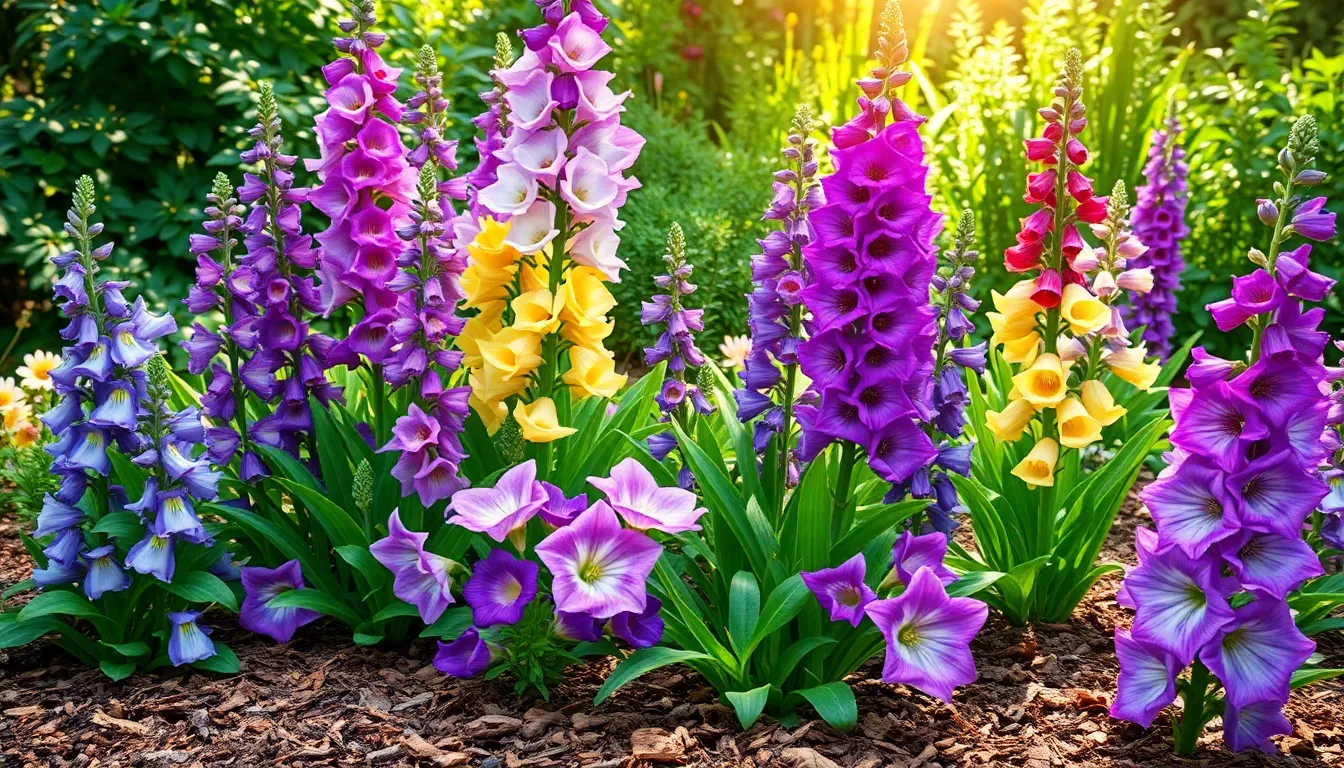
Creating stunning displays with bell shaped flowers requires understanding their exact needs and implementing proper care techniques. We’ll guide you through essential practices that ensure your campanula, foxgloves, and other bell shaped varieties thrive in your garden space.
Soil Preparation and Planting Techniques
Soil requirements for bell shaped flowers start with well drained conditions. Most campanula species and similar bell shaped varieties perform best when planted in soil that doesn’t retain excess moisture. We recommend adding compost or organic matter to heavy clay soils to improve drainage and soil structure.
Planting depth matters significantly for establishing healthy root systems. Position the roots at the same depth as they were in their containers, ensuring you don’t bury the crown of the plant. This prevents rot issues that commonly affect bell shaped flower varieties.
Sunlight needs vary among different bell shaped flower types. Bellflowers generally thrive in full sun to partial shade depending on the exact variety you’re growing. We suggest checking individual species requirements since some prefer morning sun with afternoon shade in hotter climates.
Watering and Fertilization Schedules
Watering bell shaped flowers requires consistent but moderate moisture levels. We recommend providing about 1 inch of water per week, ensuring the soil stays evenly moist without becoming waterlogged. Regular watering prevents stress that can reduce blooming in campanula and similar species.
Fertilization schedules should focus on balanced nutrition during growing seasons. Feed your bell shaped flowers with water soluble fertilizer once monthly from spring through summer to promote healthy growth and abundant blooming. This consistent feeding schedule supports vigorous development in most bell shaped varieties.
Common Pests and Disease Management
Pests that commonly affect bell shaped flowers include aphids, slugs, and snails. We recommend using organic pest control methods like neem oil applications or hand picking larger pests to protect your campanula and other bell shaped varieties naturally.
Diseases such as root rot and powdery mildew can threaten bell shaped flowers. Improve air circulation around your plants and avoid overwatering to prevent these common issues. We suggest spacing plants appropriately and pruning overcrowded growth to maintain healthy conditions.
Pruning bell shaped flowers after blooming encourages new growth. Remove spent flowers and trim back stems once the blooming period ends to prevent unwanted seed dispersal and promote continued vigor. Tall varieties may need stakes for support to prevent wind damage during peak growing seasons.
Design Ideas Using Bell Shaped Flowers in Landscapes
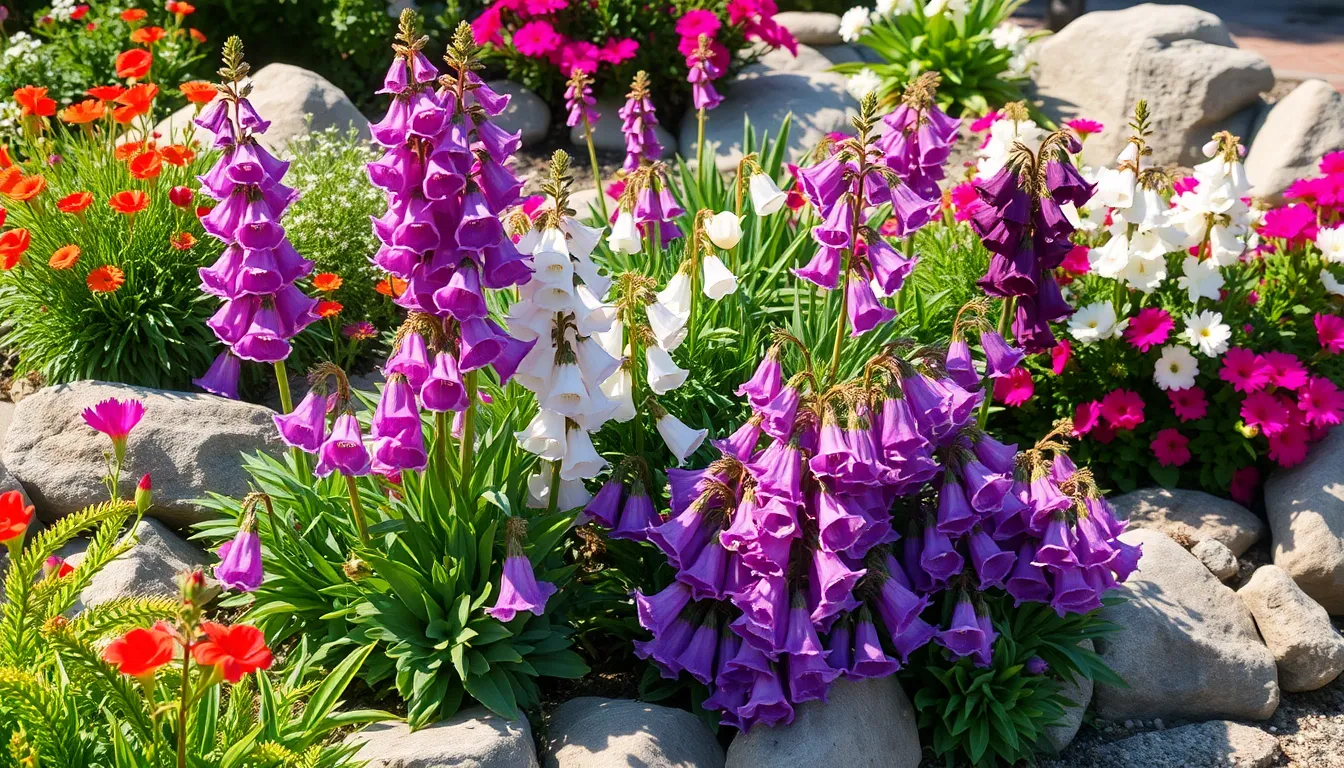
Bell shaped flowers offer incredible versatility for transforming any outdoor space into a stunning visual masterpiece. We can use their unique forms and characteristics to create ever-changing, layered gardens that captivate throughout the seasons.
Creating Height and Structure
Tall specimens like Canterbury Bells serve as natural architectural elements in our garden designs. We position these striking blooms as focal points in mixed borders, where their impressive height draws the eye upward and creates visual depth. Coral Bells work exceptionally well for establishing mid-level structure, bridging the gap between ground cover plants and taller background specimens.
Layering becomes effortless when we strategically place different heights of bell shaped varieties throughout our industry. Canterbury Bells reaching their full mature height provide the perfect backdrop for shorter companions like Million Bells cascading from elevated planters. We create dramatic vertical interest by clustering tall varieties together, then gradually stepping down to shorter specimens as we move toward garden edges.
Rock gardens benefit tremendously from the structural elements that compact bell shaped flowers provide. Clustered Bellflowers nestle perfectly among stones, creating natural looking arrangements that appear to have grown wild over time. We establish permanent structure by selecting perennial varieties that return year after year, building our garden’s backbone with reliable performers.
Color Combinations and Seasonal Planning
White Canterbury Bells paired with vibrant bluebells create one of nature’s most striking contrasts. We achieve sophisticated color schemes by combining cool tones like purple foxgloves with warm coral bells, establishing visual harmony while maintaining exciting variety. Pastel combinations work beautifully in cottage garden settings, where soft pink bleeding hearts complement pale yellow bellflowers.
Seasonal succession planning ensures we maintain continuous blooms throughout the growing season. Spring bulbs like bluebells provide early season interest, followed by lily of the valley’s fragrant white bells in late spring. We extend the display into summer with Canterbury Bells and Million Bells, creating months of overlapping color.
Planning for year round appeal requires selecting varieties with different bloom times and attractive foliage. Coral Bells offer stunning leaf colors that persist after flowers fade, while evergreen varieties provide winter structure. We create seasonal transitions by positioning early bloomers near plants that will fill in as spring flowers complete their cycles.
Mixed Border and Cottage Garden Styles
Mixed borders showcase bell shaped flowers at their absolute best when we combine them with contrasting flower forms and textures. Canterbury Bells provide vertical elements that complement rounded dahlias and spiky foxgloves, creating ever-changing compositions that engage viewers from multiple angles. We establish rhythm throughout the border by repeating bell shaped varieties at regular intervals.
Cottage garden style embraces the whimsical nature of flowers like Common Columbine and Bells of Ireland. These varieties add romantic charm when we allow them to self seed naturally, creating the informal, slightly wild appearance that defines authentic cottage gardens. Traditional elements like stone paths and rustic planters enhance the nostalgic appeal of these delicate bell shaped blooms.
Informal planting schemes work best when we group bell shaped flowers in odd numbered clusters rather than formal rows. Million Bells overflow beautifully from hanging baskets and window boxes, softening hard edges and adding romantic cascading elements. We achieve the perfect cottage garden look by mixing heights randomly and allowing plants to grow into each other naturally.
Conclusion
Bell-shaped flowers offer us an incredible opportunity to transform our gardens into vibrant and ecologically beneficial spaces. From the dramatic spikes of foxglove to the delicate carpets of bluebells these versatile plants provide year-round interest while supporting local wildlife.
We’ve explored how proper soil preparation lighting conditions and seasonal care can help us successfully grow these stunning blooms. Whether we’re creating woodland gardens rock displays or cottage-style borders bell-shaped flowers adapt beautifully to our design vision.
By choosing these remarkable plants we’re not just improving our outdoor spaces – we’re contributing to biodiversity and creating habitats that benefit pollinators. The combination of beauty functionality and ecological value makes bell-shaped flowers an excellent investment for any gardening enthusiast.
Frequently Asked Questions
What are bell-shaped flowers and what makes them unique?
Bell-shaped flowers are characterized by their distinctive drooping appearance and tubular structure formed by fused petals. Their downward-facing orientation protects reproductive parts from harsh weather while maintaining nectar concentration. These flowers feature nectar guides, hidden reproductive organs, and come in various sizes and colors, making them both beautiful and functionally adapted for attracting specific pollinators.
Which bell-shaped flowers are best for beginner gardeners?
Canterbury bells are excellent for beginners due to their reliability and ease of care. They require full sun, well-drained soil, and proper spacing to prevent fungal issues. Coral bells (Heuchera) are also beginner-friendly, offering exceptional versatility with stunning foliage and adaptability to diverse climates, making them perfect for container gardening and small spaces.
Are bell-shaped flowers safe around children and pets?
Not all bell-shaped flowers are safe. Foxglove is highly toxic to children and pets and requires careful handling during planting and maintenance. Lily of the valley is also poisonous despite its traditional uses. Always research specific varieties before planting and consider safer alternatives like Canterbury bells or coral bells in households with children and pets.
What growing conditions do bell-shaped flowers need?
Most bell-shaped flowers prefer well-drained soil and varying light conditions depending on the species. Canterbury bells need full sun, while lily of the valley thrives in shade. Foxgloves prefer partial shade to full sun in cooler climates. Proper soil preparation, consistent watering, and appropriate fertilization are essential for healthy growth across all varieties.
How do bell-shaped flowers benefit pollinators?
Bell-shaped flowers have evolved to attract specific pollinators like bees and hummingbirds. Their tubular structure and nectar guides make them particularly appealing to long-tongued bees. These flowers support biodiversity by providing essential nectar sources, with species like foxgloves specifically attracting common carder bees, enhancing overall garden ecosystem health.
When do different bell-shaped flowers bloom?
Bell-shaped flowers offer blooms throughout the growing season. Bleeding hearts provide early spring color when other perennials haven’t emerged. Lily of the valley blooms in late spring with highly fragrant flowers. Canterbury bells and coral bells bloom in late spring to early summer, while bellflowers (Campanula) can provide extended blooming periods with proper care.
How do I create natural-looking displays with bell-shaped flowers?
Layer different heights strategically, using tall specimens like Canterbury bells as backdrops and compact varieties in rock gardens. Create woodland drifts with bluebells in shaded areas, mimicking their natural habitat. Combine colors thoughtfully, such as pairing white Canterbury bells with bluebells for striking contrasts, and plan for continuous blooms throughout the season.
What maintenance do bell-shaped flowers require?
Most bell-shaped flowers need minimal maintenance. Regular watering during dry periods, annual fertilization, and proper spacing prevent common issues. Divide plants like lily of the valley every 3-4 years to maintain vigor. Clean up planting areas in late fall to prevent disease. Prune spent blooms to encourage continued flowering and overall plant health.

